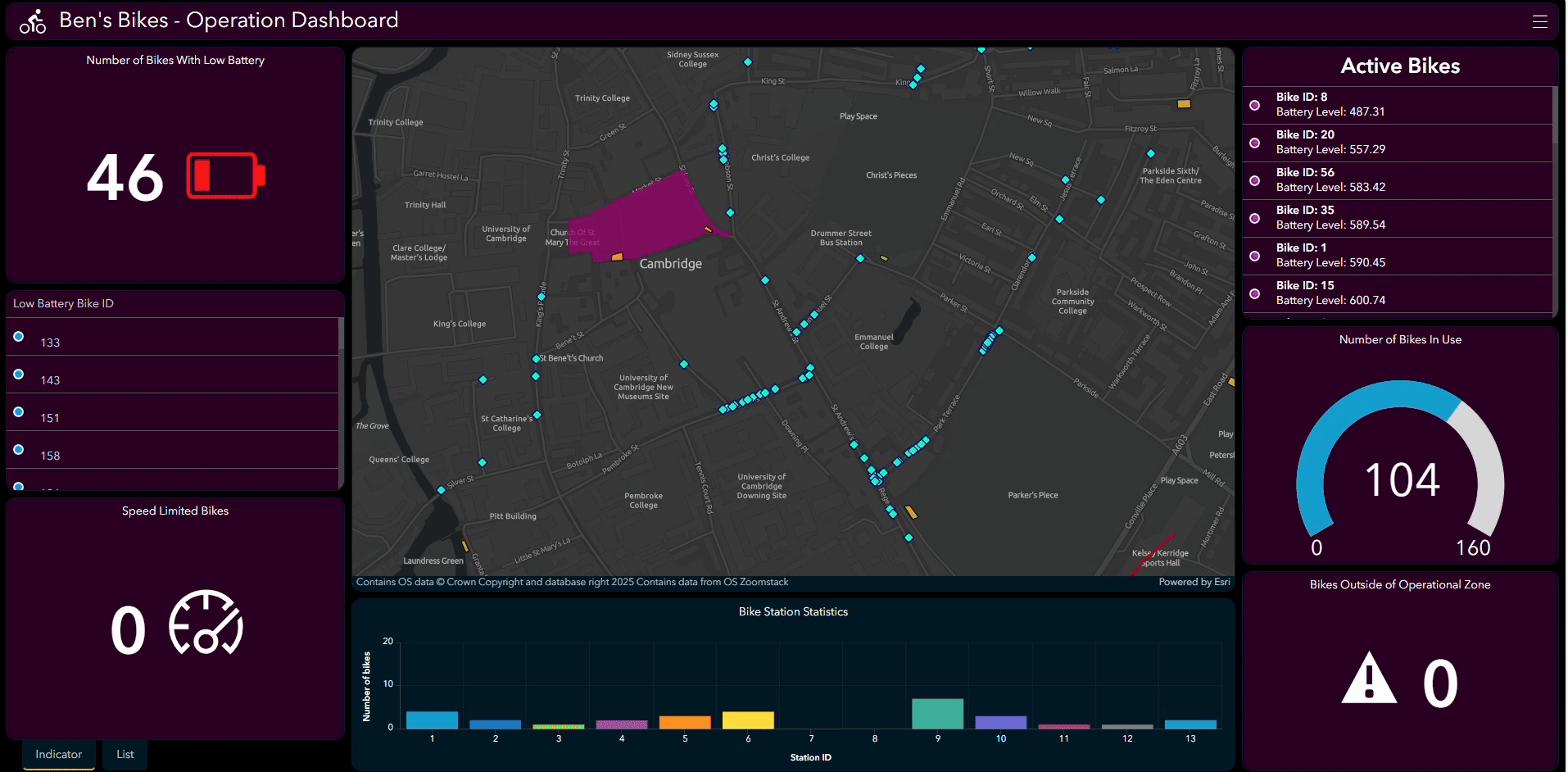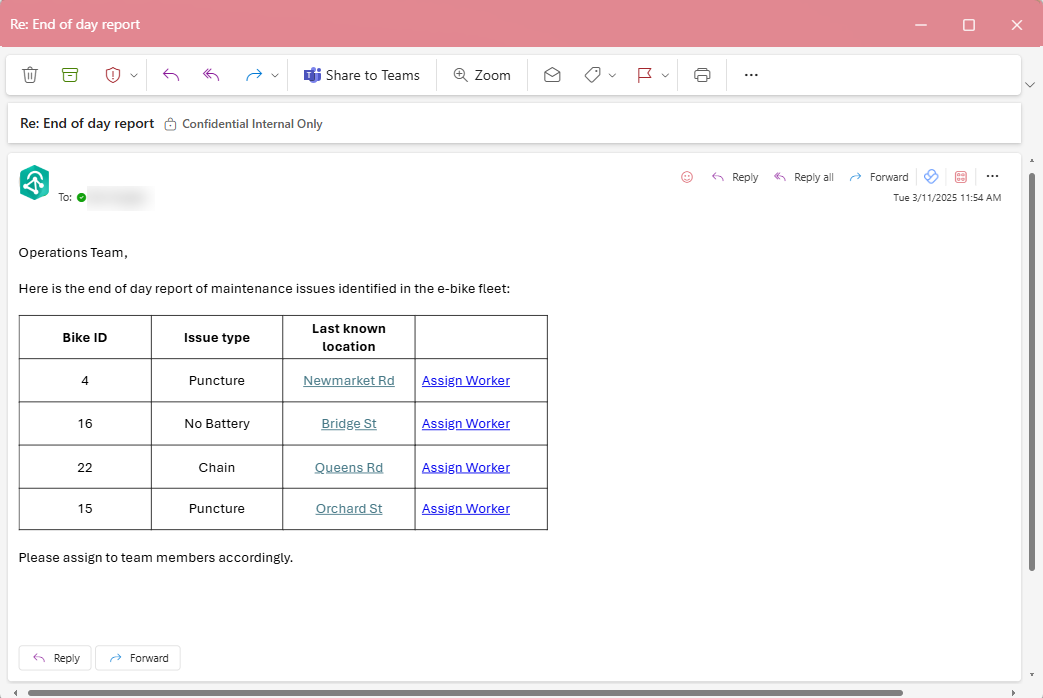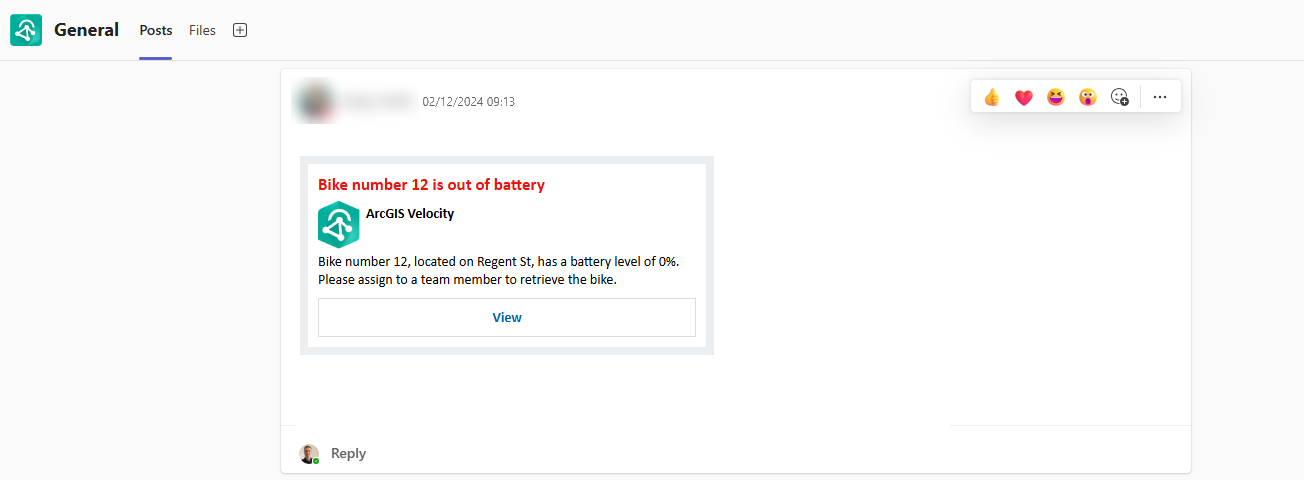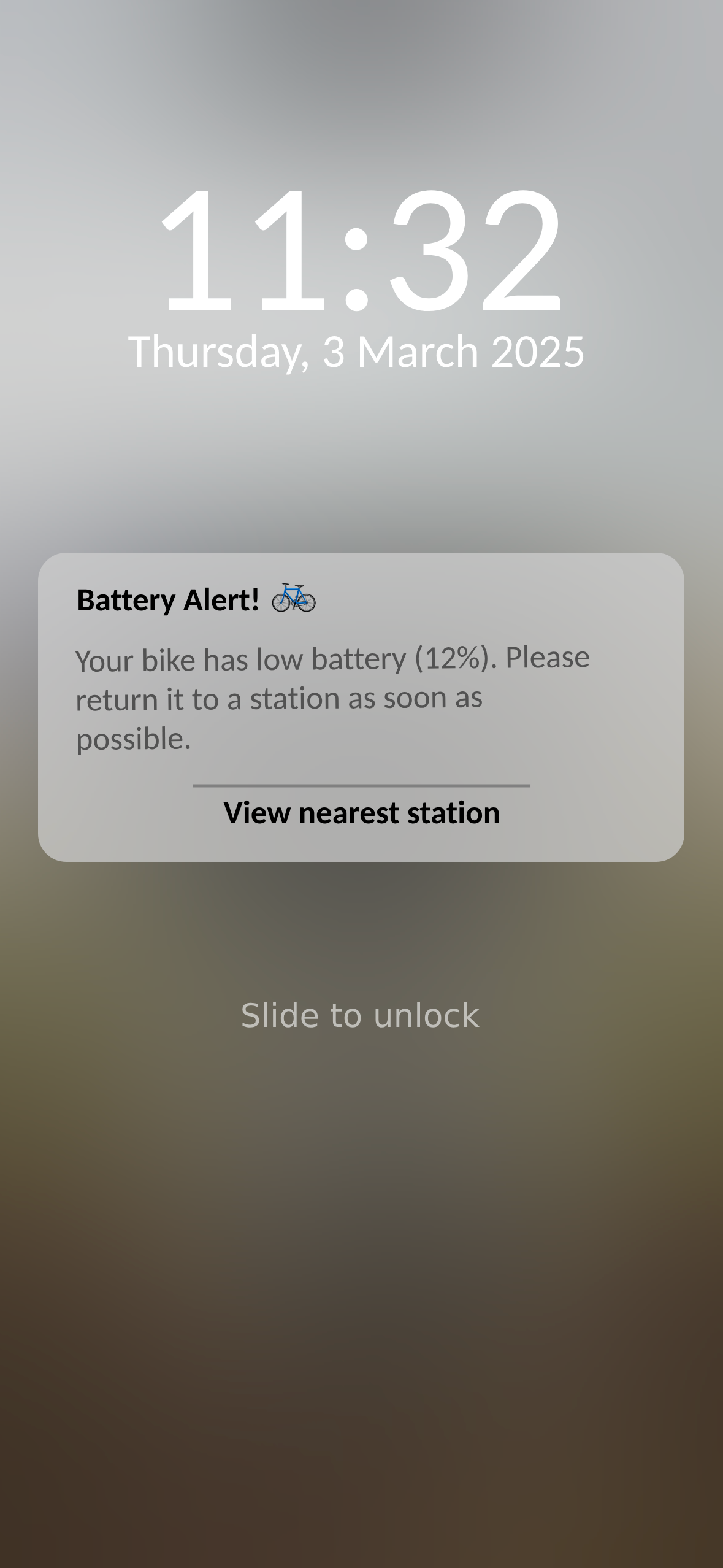When I think about how GIS has transformed the world, one thing that stands out is how it helps us to plan and understand scenarios before they happen. However, not everything can be anticipated. Some situations demand responses as events unfold.
ArcGIS Velocity, a real-time and big data processing capability in ArcGIS Online, takes live data and makes it useful for quick decisions. Whether it’s monitoring public safety incidents, optimising logistics, or responding to environmental hazards, Velocity helps teams to respond quickly and effectively to events as they unfold. By offering a range of alerting outputs – such as sending a text message, a Microsoft Teams message, or triggering an HTTP request – ArcGIS Velocity ensures the right people get the right information exactly when they need it, even if that’s to multiple places at once.
Let’s explore these alerting outputs in more detail – what they do, when you might use them, and the key parameters involved. To illustrate how different alerting outputs could work in practice, we’ll use a unified scenario throughout this blog: managing a fleet of e-bikes across a city. Each example (flagged by ![]() ) will show how alerts can enhance operations by notifying the right people at the right time.
) will show how alerts can enhance operations by notifying the right people at the right time.

Text Message
The Text Message output in ArcGIS Velocity lets you send real-time alerts directly to mobile devices using an externally accessible SMTP server. By configuring the subject and message body with Arcade expressions, you can ensure the alerts contain relevant information, making it easier for stakeholders to respond quickly.
One of the main advantages of using text messages is their immediacy—recipients are more likely to see and respond to a text than an email, especially in urgent situations, or when on-the-go. The Text Message output is ideal for scenarios where the volume of alerts is relatively low. If there’s a lot of activity, HTTP outputs or email might be a better choice to avoid overwhelming an SMTP server or recipients.
Key parameters include the SMTP host, encryption type, sender’s address, and recipients. These can be configured manually or from existing data fields. To prevent server overload, ensure the rate of messages aligns with the server’s capacity.
![]() When a bike has been stationary outside the operational area for more than 30 minutes, a text message is sent directly to the field team’s mobile devices. The message includes the bike ID, its last known location and a link to view the status on a map. The message prompts a quick response and has the information needed to retrieve or reposition the bike.
When a bike has been stationary outside the operational area for more than 30 minutes, a text message is sent directly to the field team’s mobile devices. The message includes the bike ID, its last known location and a link to view the status on a map. The message prompts a quick response and has the information needed to retrieve or reposition the bike.
The Email output in ArcGIS Velocity enables you to send detailed notifications via email using an externally accessible SMTP server. By configuring the subject and message body with Arcade expressions, you can include attribute-specific information.
Emails are best suited for conveying more detailed information or when communicating with a broader audience, such as external stakeholders. If time is of the essence, other outputs may work better.
Key parameters include the SMTP host, encryption type, sender’s address, and recipients. These can be set manually or derived from data fields. To prevent server overload, consider the volume of alerts and adjust the configuration accordingly.
![]() At the end of each day, an email summary is sent to the operations team detailing bikes that require maintenance. The email includes a table listing each bike’s ID, last known location and issue type. This provides a clear and organised overview to plan maintenance tasks efficiently.
At the end of each day, an email summary is sent to the operations team detailing bikes that require maintenance. The email includes a table listing each bike’s ID, last known location and issue type. This provides a clear and organised overview to plan maintenance tasks efficiently.

HTTP
The HTTP output in ArcGIS Velocity let’s you send data to other systems using POST, PUT, or DELETE requests. Each output feature generates a separate request, making it suitable for scenarios where incidents occur infrequently. By leveraging Arcade expressions, you can format JSON payloads dynamically to ensure proper structure and context.
Compared to other outputs, the HTTP output is incredibly flexible, allowing integration with a wide range of external systems and APIs. However, due to the potential for a high volume of requests, it is crucial to consider rate limits and the capacity of the target web server. For more complex scenarios, authentication options like Basic and OAuth 2.0 are available, allowing secure communication with APIs.
Key parameters include the endpoint URL, HTTP method (POST, PUT, DELETE), content-type headers (such as JSON or XML), optional URL parameters and custom headers. When using OAuth authentication, an access token must be retrieved and incorporated into requests using the $accessToken global variable.
![]() When an e-bike enters a pedestrian-only area, an HTTP output could be configured to send a request to the bike’s firmware, automatically limiting its speed until it exits the zone.
When an e-bike enters a pedestrian-only area, an HTTP output could be configured to send a request to the bike’s firmware, automatically limiting its speed until it exits the zone.
Microsoft Teams and Slack
ArcGIS Velocity allows you to integrate with communication systems your organisation might already be using – like Microsoft Teams or Slack. If these tools are already part of your workflow, these output options could be a great fit.
Microsoft Teams
The Microsoft Teams output lets you send Adaptive Cards to Teams channels or chats using a webhook URL. These cards can include text, graphics, and buttons. These provide an interactive way to communicate alerts and analysis results directly to teams. Using Arcade expressions, you can tailor messages with relevant details for better context. This output option is ideal for sending useful information directly to the people that need them. Key information passed through interactive cards can be sent to shared team environments, streamlining collaborative decision-making and response times. However, if the alerts are highly detailed or need to reach external stakeholders, other options such as emails might be a better fit.
Key parameters include the Microsoft Teams Webhook URL and a JSON POST body, which must be wrapped in the Text() Arcade function for proper formatting. Be mindful of Adaptive Card schema requirements and message size limits to avoid errors or truncation.
![]() When a bike is out of charge, an Adaptive Card to is sent to notify the maintenance team via Microsoft Teams. This card includes key information—such as the e-bike ID, its current location on a map, and actionable buttons like “Assign Technician” or “View in Dashboard.”
When a bike is out of charge, an Adaptive Card to is sent to notify the maintenance team via Microsoft Teams. This card includes key information—such as the e-bike ID, its current location on a map, and actionable buttons like “Assign Technician” or “View in Dashboard.”

Slack
Similar to the Microsoft Teams output, the Slack output in ArcGIS Velocity enables you to send interactive messages to Slack channels using a webhook URL, including text, graphics, and buttons. Again, by incorporating Arcade expressions, you can dynamically insert attribute-specific information into your messages. Slack is ideal when alerts need to trigger follow-up actions in integrated apps or when teams need to reference alerts later without them getting buried in chat history. However, like the Microsoft Teams output, if the alerts are highly detailed or need to reach external stakeholders, other outputs might be a better fit.
Key parameters include the Slack Webhook URL and a JSON POST body, which must be wrapped in the Text() Arcade function for proper formatting. Be cautious of Slack’s rate limits and message length restrictions to avoid throttling or truncation.
![]() When a bike exits the operational area, a message is sent to a Slack channel. These messages include key details like the bike ID, location, and a link to view it on a map, ensuring the team has all the information needed to act fast.
When a bike exits the operational area, a message is sent to a Slack channel. These messages include key details like the bike ID, location, and a link to view it on a map, ensuring the team has all the information needed to act fast.

Amazon Simple Notification Service (SNS)
The Amazon SNS output in ArcGIS Velocity enables you to send features or Arcade-generated messages to Amazon Simple Notification Service. As a fully managed pub/sub service, SNS supports A2A (application to application) and A2P (application to person) messaging, allowing notifications through push notifications, SMS, and email. This makes it a great choice for sending multiple alerts to multiple devices or people at once – of course you can also connect multiple outputs to your ArcGIS Velocity analytic to achieve this.
Compared to other outputs, Amazon SNS is particularly useful for reaching multiple subscribers in real-time, such as field workers or mobile application users that need immediate updates. Its ability to handle multiple data formats, including JSON, GeoJSON, and Esri JSON, makes it versatile for various scenarios. Make sure your AWS keys and permissions are configured securely to ensure successful delivery.
Key parameters include the AWS access key, secret key, region, and the ARN (Amazon Resource Name) for the SNS topic. Messages can be constructed dynamically using Arcade expressions for greater context and customisation. The secret key is encrypted upon saving the analytic for security purposes.
![]() When an e-bike has a low battery, a push notification is sent to the riders phone advising them to return the bike to a station, along with details of the nearest station.
When an e-bike has a low battery, a push notification is sent to the riders phone advising them to return the bike to a station, along with details of the nearest station.

Final thoughts…
One of ArcGIS Velocity’s key strengths is its ability to integrate real-time data processing with the external systems your team already relies on. By delivering critical information to Microsoft Teams, Slack, text messages, emails, or any combination of these, the flexible output options in ArcGIS Velocity help the right people receive the right insights at the right moment.
Want to learn more? Here are some more Velocity-focused resources ready for you to explore:
- our previous webinar on “Getting up to speed with real-time in ArcGIS”.
- our “A quick guide to ArcGIS Velocity” blog.
- a learning plan to “Get started with ArcGIS Velocity”.
- the ArcGIS Velocity documentation.